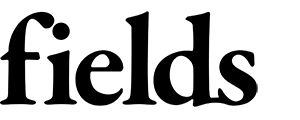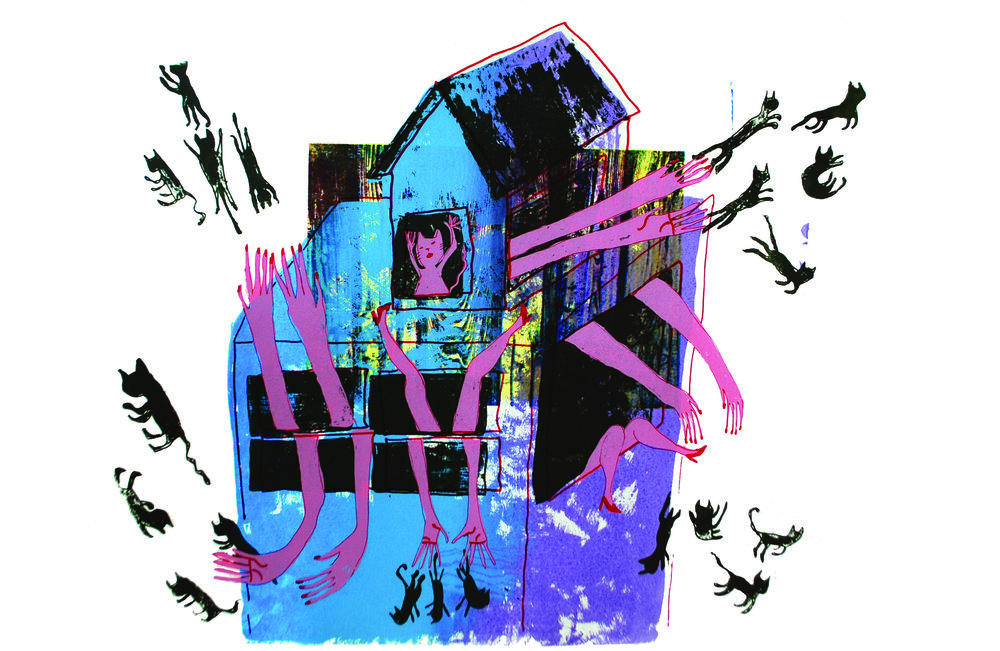interview: Justine Kelley
Justine Kelley is a Philadelphia-based printmaker and recent graduate of the Tyler School of Art. She spoke to us about discovering screen printing later in her education and the process behind her colorful prints.
Welcome 2 Jr High (2013)
First off, can you describe your background and your work?
JK: I recently graduated from Tyler School of Art in Philadelphia and am currently working part-time at a community printmaking shop called Second State Press. I grew up in a pretty small town where people weren’t really interested in art; out of my huge high school graduating class, I think I was the only person who chose to go to art school. A lot of people say that art school is a waste of time/money and you can be an artist without going to art school, which is sometimes true, but I think for people like me who, up until college, had little to no exposure to other art makers, the sense of community that art school gave me was quite important. And until I took a printmaking class, I didn’t really understand my relationship with my own work; I knew what I liked and what I didn’t like, but I didn’t understand how it translated into my work.
I mostly screen print on paper and am drawn to bright colors. The nature of printmaking is that you can create an image or matrix in black and white, or carve it into wood/etch into copper, etc., before the inked image is pressed onto the paper. So a lot of the time my color picking is really spontaneous/hit or miss, or a bit of an afterthought. Sometimes things turn out unexpectedly well, and spontaneity is something I love about printmaking, but I’m going to try to be more intentional with color as well. Layering is also really important in my prints, and finding ways for the layers to interact. Layering in printmaking is very different from layering in painting or drawing because you have to create them separately. It’s always a challenge to make the layers harmonious because you create each layer individually.
What have your influences (or favorite things) of late been? And perhaps, even what you’ve been influenced by in the past. Do you find inspiration from any unexpected sources?
JK: I was surprised to realize that I now am inspired by the same things as when I was a kid. I would draw lots and lots of animals, which I still do, and when I look back at my childhood drawings the style is really similar. I’m definitely influenced by people, animals, and food. Food is a huge theme in my life and has been such a focus since I was young, more so than I think was normal for most children, so that definitely comes through in my work as well. I also draw inspiration from relationships between humans, relationships between humans and animals, humans and food, humans and technology, and the figurative aspects of those relationships. I still feel really new at being an artist. I’ve been drawing pretty much since I was born, but I’ve been “making art” for so much less time, so I’m still learning what exactly is significant influence in my work.
Printmaking really highlights and lends itself to your specific style and subjects—have you always been focused on it? How long did it take to find a media that really complemented you and what you wanted to achieve creatively?
JK: As I mentioned earlier, it took me awhile to realize what I wanted to focus on. It took me up until two and a half years ago to realize that I wanted to be a printmaker, but now I also want to try working with other mediums. Screen printing was really good for helping me to realize where my art fits in with the rest of the art world: a sort of compromise between graphic art and fine art. Drawing has always been my strong point and I love screen printing because it’s so easy to turn one drawing into a whole edition, or turn a doodle into a finished print.
Burning House (2011)
What are your creative process and methods like? Talk us through the beginning of an idea to its final form as a finished piece.
JK: I’ve been primarily making prints on paper for the past two years, so I’m definitely wanting to try other things. I love ceramics and I’d be thrilled to make things out of clay, like little animal figurines or translating figures from a drawing into a 3D form. I also really miss creating repeat patterns on fabric yardage, but I haven’t had access to long tables to facilitate that since I graduated, so I might have to settle with making patterns on Photoshop. I’ve started to think about ways to utilize the relationship between the viewer and space and want to one day have a show that uses my fabric yardage as a sculpture because lately I’ve just been using it to make scrunchies. I also want to start painting, but I’m feeling apprehensive because last time I tried I was really bad at it.
When I’m making a piece it usually starts with an idea of an action or image of a figure performing an action, and from there I draw a multi-layered image on sheets of mylar or tracing paper. I usually don’t sketch out things beforehand, because I’m impatient, so the result is always a surprise when it comes time to print. My work is very much impulsive, which kind of negates the nature of printmaking, a medium that requires so much planning and waiting time (in between washing screens, coating, exposing, ink drying, etc.) In the past I’ve relied on the “surprise image” as a source of satisfaction in my work, but in the future I want to be more intentional in my drawings and focus more on the hand-drawn image, rather than nuances and exciting mistakes in printmaking.
However, on the other side of things, I’ve known people who spend months and months working on one single print, using agonizing detail and making hundreds of proofs, and I have never felt the desire to do that. That much dedication and commitment to one work gives me anxiety and I see it more as stifling rather than promoting personal growth, but everyone works differently and I could probably learn a lot from spending that much time with one print.
You describe printmaking as a largely trial-and-error-based medium. Can you talk more about one of your “exciting mistakes” that’s turned into a piece that you ended up liking a lot?
JK: Probably the most exciting mistakes are when the layer colors interact in unexpected ways, which is awesome to see because you really have no idea what the final result is until you start printing. Sometimes misregistered prints end up looking more interesting than perfectly registered prints, or sometimes the ink has an interesting texture when it transfers to the paper for whatever reason, which is why screen-printed work, or any kind of manually printed work, is way more exciting to me than digital.
Are there any specific artists or art movements you draw inspiration from, or that you find yourself drawn to?
JK: A few artists off the top of my head that I really love are Charlotte Mei, Alex Schubert, Rob Coradetti, Ginette Lapalme, Ellie Andrews, Emma Louthan... A bunch of my favorite artists are just illustrators whose work I randomly found on the Internet. I love illustration with a sense of humor and great colors, but that is still sincere and earnest.
Pizza Ghosts (2012)
The themes in your work are very relatable but also feel very personal. Can you talk more about specific imagery that you come back to over and over in your work?
JK: I’ve always been interested in exploring figures in different contexts in everyday life, like the relationships humans have to certain objects, focusing on the positions of the body. A person texting on a cell phone or typing on a computer has a specific relationship between their body and the object, and I’ve recently enjoyed thinking about that when drawing. Any pose that involves a person doing something with their hands as an extension of their body is fun and funny to me. As for other imagery like animals, fruits, and plants, the only explanation I can think of is those were the things I really loved when I was a kid. As a child I was always thinking of food and animals, so I guess it makes sense that I would turn to that imagery now.
Can you tell us about your show Coconut Club Pineapple Pleasure?
JK: Coconut Club Pineapple Pleasure was my senior show at Tyler School of Art. I hung nearly all my work from throughout college and they surprisingly meshed well together, probably because I often use a lot of the same colors, so I was happy with the result. Before I started hanging the show I was going to just have a few of my recent prints on a wall, but the more I thought about it, the more I wanted to take the “more is more” approach and layer prints on fabric, show my pizza pillows, pair different mediums together, and even include the first screen prints I ever made. I felt like it worked with the nature of my process: thinking about how different layers can work together unexpectedly, and thinking about the concept after finishing the work. Some artists have shows with very few pieces, so the viewers can focus on each individual piece without distraction, but I didn’t feel like the amount of work I included took away from the attention of the viewer on each individual piece. Rather, it forced each separate work to relate to each other.
See more of Justine Kelley's visual art.
Interview by Caroline Knowles.



